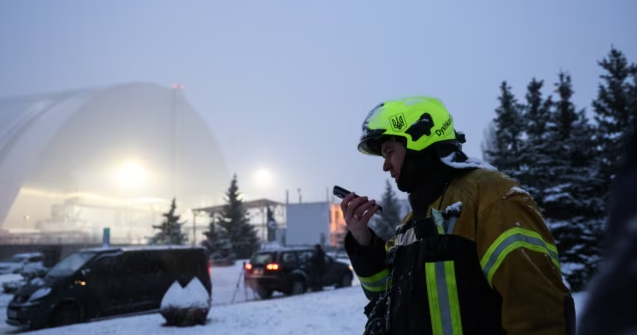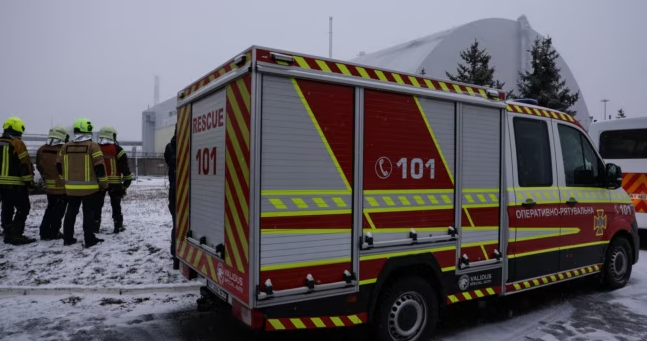Radiation under attack. What led to the Russian drone strike on the Chernobyl shelter

On the night of February 14, a few hours before the Munich Security Conference, the Russian army attacked the shelter that contains radioactive radiation from the 4th power unit of the Chernobyl nuclear power plant with a drone. Ukrainian President Volodymyr Zelensky said in Munich that the hit was not accidental: According to him, the drone was at an altitude of 85 meters, and radars could not see it. Independent expert Olga Kosharna shares the same opinion: “Putin is showing that there are no red lines for him, that the international nuclear community has not found ways to control and stop his terrorist nuclear activities. He is demonstrating strength. And first of all, before the Munich Conference.”
The press secretary of the Russian president, Dmitry Peskov, denied the targeted strike: he said that “there is no question of any strikes on any nuclear infrastructure facilities, nuclear energy infrastructure.”
The wreckage of a Geran-2 (Shahed) drone with a high-explosive warhead was recorded at the site of the attack. Despite the fact that the shelter structure is damaged, the radiation background remains within permissible values, and there was no leakage of radioactive substances, the Security Service of Ukraine reported.
The shelter facility (confinement) is an engineering structure that has no analogues in the world. It was built with funds from donors from the G7 countries to cover the concrete sarcophagus, which, at great risk to the lives of the builders, was used to cover the 4th power unit of the Chernobyl NPP in the first months after the accident. As a result of the strike, a fire broke out. The wreckage of a Russian drone was found near and inside the shelter, the Security Service of Ukraine reported.
The wreckage of the drone that struck the Chernobyl nuclear power plant. It bears the drone type marking Geran-2 (Shahed) and the tail number. Russia has officially denied that it carried out the attack on the Chernobyl nuclear power plant.
According to the State Emergency Service, there is currently no data on the increase in the radiation background as a result of the drone hitting the shelter above the 4th power unit of the Chernobyl nuclear power plant and the fire that broke out. At the moment, we can say that the open fire that arose as a result of the attack was extinguished by rescuers; spokeswoman Svitlana Vodolaga told the department.

According to the spokeswoman of the State Emergency Service, smoldering remains in one of the cells, firefighters are working to eliminate it.
According to the investigation: the kamikaze drone is equipped with a high-explosive warhead for maximum fire damage.
According to the President of Ukraine Volodymyr Zelensky, the drone was flying at an altitude of 85 meters. This makes it almost impossible to fix the drone on radar. The sarcophagus itself; not damaged, but the shelter needs urgent repair. All nuclear power plants are very strong, but not designed for attack by armed forces.
Heavy snow continued to fall at the site of the impact. According to Kateryna Shavanova, precipitation could lead to further destruction of the shelter
Representatives of the Ukrainian and international media arrived at the site of the attack.
Services are working directly on the damaged shelter. Under it; the fourth power unit of the Chernobyl NPP, which exploded in 1986, leading to the largest man-made disaster in the history of nuclear energy.
Services are working directly on the damaged shelter. Below it is the fourth power unit of the Chernobyl nuclear power plant, which exploded in 1986, leading to the largest man-made disaster in the history of nuclear energy.
Work to restore the shelter may prove difficult, because the protective structure around the fourth power unit of the nuclear power plant is a complex engineering structure, says Sean Burnie, a nuclear power expert in Central and Eastern Europe, in a commentary for Radio Liberty. The confinement was first erected next to the sarcophagus, and then slid onto it on rails.
After the Russian attack on the Chernobyl nuclear power plant on February 14, the Ukrainian Energy Ministry called on the IAEA to intensify all international efforts to force Russia to stop terrorist attacks on nuclear facilities. Ukrainian Foreign Minister Andriy Sybiga said that the IAEA Council would consider the Russian attack on the Chernobyl sarcophagus at its next meeting.
